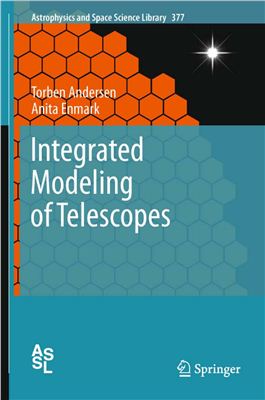Springer Science+Business Media, New Yourk, 2011, 545 pages
Ground- or space-based telescopes are becoming increasingly more complex and construction budgets are typically in the billion dollar range. Facing costs of this magnitude, availability of engineering tools for prediction of performance and design optimization is imperative. Establishment of simulation models combining different technical disciplines such as Structural Dynamics, Control Engineering, Optics and Thermal Engineering is indispensable. Such models are normally called Integrated Models because they involve many different disciplines. The models will play an increasingly larger role for design of future interdisciplinary optical systems in space or on ground. The book concentrates on integrated modeling of optical and radio telescopes but the techniques presented will be applicable to a large variety of systems. Hence, the book will be of interest to optical and radio telescope designers, designers of spacecrafts that include optical systems, and to designers of various complex defense systems. The book may also find use as a textbook for undergraduate and graduate courses within the field. "Adaptive Optics" is an exciting and relatively new field, originally dedicated to correction for blurring when imaging through the atmosphere. Although this objective is still of high importance, the concept of Adaptive Optics has recently evolved further. Today, the objective is not only to correct for atmospheric turbulence effects but also for a range of static and dynamical telescope aberrations. The notion of adaptive optics has expanded to the field of "Wavefront Control", correcting for a variety of system aberrations. Wavefront control systems maintain form and position of optical elements with high precision under static and dynamical load. In many ways, such systems replace the steel structures of traditional optical systems, thereby providing much lighter systems with a performance not possible before. Integrated Modeling is the foremost tool for studies of Wavefront Control for telescopes and complex optics and is therefore now of high importance. Springer has recently published two books on telescopes, "Reflecting Telescope Optics" by R. Wilson, and "The Design and Construction of Large Optical Telescopes" by P. Bely. Noting that a new (and expensive) generation of Extremely Large Telescopes with apertures in the 30-100 m range is on the way, the present book on integrated modeling is a good match to the existing books and an appropriate specialization and continuation of some subjects dealt with in those books.
Ground- or space-based telescopes are becoming increasingly more complex and construction budgets are typically in the billion dollar range. Facing costs of this magnitude, availability of engineering tools for prediction of performance and design optimization is imperative. Establishment of simulation models combining different technical disciplines such as Structural Dynamics, Control Engineering, Optics and Thermal Engineering is indispensable. Such models are normally called Integrated Models because they involve many different disciplines. The models will play an increasingly larger role for design of future interdisciplinary optical systems in space or on ground. The book concentrates on integrated modeling of optical and radio telescopes but the techniques presented will be applicable to a large variety of systems. Hence, the book will be of interest to optical and radio telescope designers, designers of spacecrafts that include optical systems, and to designers of various complex defense systems. The book may also find use as a textbook for undergraduate and graduate courses within the field. "Adaptive Optics" is an exciting and relatively new field, originally dedicated to correction for blurring when imaging through the atmosphere. Although this objective is still of high importance, the concept of Adaptive Optics has recently evolved further. Today, the objective is not only to correct for atmospheric turbulence effects but also for a range of static and dynamical telescope aberrations. The notion of adaptive optics has expanded to the field of "Wavefront Control", correcting for a variety of system aberrations. Wavefront control systems maintain form and position of optical elements with high precision under static and dynamical load. In many ways, such systems replace the steel structures of traditional optical systems, thereby providing much lighter systems with a performance not possible before. Integrated Modeling is the foremost tool for studies of Wavefront Control for telescopes and complex optics and is therefore now of high importance. Springer has recently published two books on telescopes, "Reflecting Telescope Optics" by R. Wilson, and "The Design and Construction of Large Optical Telescopes" by P. Bely. Noting that a new (and expensive) generation of Extremely Large Telescopes with apertures in the 30-100 m range is on the way, the present book on integrated modeling is a good match to the existing books and an appropriate specialization and continuation of some subjects dealt with in those books.

